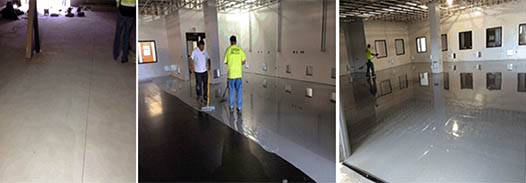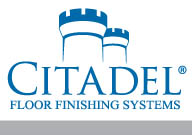Project of the Month:
Citadel Concrete Protection Systems ESD Floor
Project Name: Isometric Tool And Design - New Richmond, WI
Project Description: 3,000 sq.ft. 32 mil thick ESD Static Dissipative Control Coating
Electrostatic discharge causes a shocking $5 billion in lost profits annually. With Citadel's Concrete Protection Systems line of products you can now protect yourself with Conductive and Static Dissipative floor toppings and coatings. Just walking across the floor can generate as much as 3,000 volts. It takes as little as 10 volts to cause damage to sensitive equipment and products, even ignition of flammable solvents and chemicals. ESD Control systems provide more effective protection against static and sparking than tile, carpet, and mats.
As a manufacturer of ultra-precise medical devices, the client has very sensitive equipment that cannot encounter Electrostatic discharge. With our ESD coating, we were able to easily solve this problem and give the client peace of mind that their equipment is protected.

Monthly Product Highlight: SLE-100
SLE-100 SLE-100 is a 100% solids Epoxy, primer/basecoat that has exceptional adhesion properties to concrete substrates. Due to its unique chemistry, this coating exhibits great flexibility, working times and self-leveling properties while offering great chemical resistance as well. Low odor makes it a great choice for interior applications. What makes SLE-100 stand out from every other 100% Solids epoxy, is that is virtually odorless, has a 60 minute pot life, and VOC free. It can be applied direct to concrete in a single self-leveling coat, or as a primer/basecoat for broadcast systems. SLE-100 is sold clear in 3 gallon kits, or can be pre-tinted tan or gray. It can be applied from 90sqft/gallon (18mils) up to 400sqft/gallon (4mils). SLE-100 dries to tack-free state in 10-12 hours, and 48 hour drive on time. Maximum re-coat window is 72 hours.
Upcoming Events: Get Certified!
Become a certified Citadel Products installer by attending a training seminar. Citadel training sessions are
typically held on a monthly to bi-monthly basis depending on the number of interested parties. We
always welcome new installers but even if you have been to a previous session, consider a refresher
course because we are constantly working to improve installation techniques. Who knows, you may just
learn a new technique that could save you time and money! Please let us know if you are interested in
attending a training seminar, we would love the opportunity to showcase our current products and also
any new products and installation techniques!!
Click here for registration information
Tech Tip:
Concrete Hardness
When installing a coating system over a concrete substrate, it is important to test for the hardness of the concrete. If densifiers and hardeners were used in the concrete mix, chances are your prep time and efforts are going to drastically increase.
Citadel offers an easy test method for finding out the hardness of the concrete, in order to better help you estimate the amount of prep and which diamond bond segment that will be needed to reach the desired profile. If that profile is not met, the chances of a coating failure increase. The general rule is the harder the concrete, the softer the bond.
The Mohs Hardness Test is a series of double ended picks with 8 points comprising 2,3,4,5,6,7,8 and 9 on Mohs hardness scale. To test for hardness of a substrate, simply scratch the surface of your concrete with the picks of various indicated hardness. As an example, if a No. 5 pick scratches the concrete, but a No. 4 pick does not, then your concrete's hardness is 4.5. Then compare this against the table of minerals listing hardness values to aid in determining which bond to use on your grinder to get the profile needed.
By choosing the correct bond, you will not only achieve the correct profile, but also save on diamond bonds.
|



